A History of the Mishnaic Law of Purities, Part 16: Niddah: Literary and Historical Problems (Studies in Judaism in Late Antiquity) 9781597529402, 1597529400
The history of Jews from the period of the Second Temple to the rise of Islam. From 'A History of the Mishnaic Law
126 76 19MB
English Pages 248 [249] Year 2007
Recommend Papers

- Author / Uploaded
- Jacob Neusner (editor)
File loading please wait...
Citation preview
STUDIES IN JUDAISM IN LATE ANTIQUITY EDITED BY
JACOB NEUSNER
VOLUME SIX
A HISTORY OF THE MISHNAIC LA \v OF PURITIES PART
SIXTEEN
.A HISTORY OF THE MISHNAIC LAW
OF PURITIES PART SIXTEEN
A HISTORY OF THE MISHNAIC LAW OF PURITIES BY
JACOB NEUSNER University Professor Professor of Religious Studies and The Ungerleider Distinguished Scholar of Judaic Studies Brown University
PART SIXTEEN
NIDDAH LITERARY AND HISTORICAL PROBLEMS
Wipf&Stock PUBLISHERS Eugene,Oregon
Wipf and Stock Publishers 199 W 8th Ave, Suite 3 Eugene, OR 97401 A History of the Mishnaic Law of Purities, Part 16 Niddah: Literary and Historical Problems By Neusner, Jacob Copyright©1977 by Neusner, Jacob ISBN 13: 978-1-59752-940-2 ISBN 10: 1-59752-940-0 Publication date 3/19/2007 Previously published by E. J. Brill, 1977
For Louis Finkelstein in appreciation
TABLE OF CONTENTS Preface
....
Abbreviations and Bibliography. Transliterations Introduction XII. Mishnah-Tosefta Niddah. Translation XIII. Mishnah and Tosefta . . . . . . . i. The Relationship between Mishnah and Tosefta . ii. The Organization and Redaction ofTosefta iii. Tosefta as Commentary to Mishnah . . . . . iv. Tosefta as a Corpus of Autonomous Materials v. The Two Sources of Tosefta . . . . . . vi. The Two Sources ofTosefta: Literary Traits 1. Forms . . . . . 2. Attributions vii. Cumulative Summary . viii. Conclusion . . . . . XIV. Forms and Formulary Patterns i. Introduction ii. Forms . . . . . . . . . 1. Lists and Ladders . . . 2. Stories, Narratives, and Precedents 3. Disputes and Debates . iii. Formulary Patterns . . . . . . . 1. Apocopation . . . . . . . . . 2. The Declarative Sentence: Formally Disciplined and Balanced Sentences in a Major Unit of Tradition . . . . . . . . . . . . . 3. The Declarative Sentence: Mishnah's and Tosefta's Glosses ofMishnah 4. The Declarative Sentence: Miscellaneous iv. Conclusion . XV. Attributions . . . i. Introduction
IX
xm xvru 1 13 70 70 71 76 79 80 83 83 88 89 91 92 92 96 97 98 99 103 104
104 105 108 110 114 114
VIII
TABLE OF CONTENTS
ii. Unattributed Traditions. ~B~rem iv. Yavneh . . v. Usha. . . vi. After Usha XVI. The Weaving of the Law i. The Thematic Units of Niddah ii. Unclean Body-Fluids . . . . iii. Doubts about Unclean Body-Fluids iv. The Stages of the Law v. Assignments, Attestations, and Attributions: Reconsiderations . . . . vi. The Weavers of the Law . vii. Conclusion .
117 1~ 121 122 126 127 127 128 151 181 185 188 191
XVII. Niddah before 70 . 194 i. Introduction 194 ii. Scripture and Mishnah: Oral Torah as the Completion of the Written Torah . . . . . . 195 iii. Sectarian Views of Menstrual Uncleanness 201 iv. Conclusion . . 208 Index to Parts XV and XVI
212
PREFACE Mishnah-Tosefta Niddah constitutes an extended commentary upon the basic law of Scripture, in particular, Leviticus 12: 1-8, the uncleanness of the woman after childbirth, Lev. 15:19-24, the uncleanness of the menstruant, and Lev. 15: 25-30, the uncleanness of the Zabah, the woman who has a flow of blood after the menstrual period. There is no important idea which does not derive, directly or derivatively, from the Scriptural provision of the matter. At no point does the tractate raise questions which are not provoked by Scripture itself. Furthermore, I discern no organizing problematic, no single concern, which both unifies the tractate and clearly stands at its very foundations, other than the specified statements of the facts in Scripture. And these hardly constitute a problematic. They are merely statements of data, augmented by Mishnah with more data. The tractate is conceptually diffuse, without a logical center or organizing problematic. Only one authority turns out to see things whole, and that is Meir. He comes at the end of the process, not at the outset, drawing together secondary and tertiary issues. The inner structure of the tractate therefore is factual, not conceptual an_d logical, and provokes a quite different set of questions from that applicable earlier. Let us begin by summarizing the substance of the law and, in particular, showing in general terms the remarkably close relationship between Mishnah and the Priestly Code on the menstruant and Zabah. For this purpose we turn to the fine account by Israel Moses Ta-Shma (Enryclopaedia Judaica 12:1141-1148). As to the Scriptural and Talmudic strata, he says: According to the literal meaning of the biblical passages. . . the law is thus: A woman who discerns blood within and up to a period of seven days is "impure" for those seven days from the time the blood first appears. On the eighth day-if she sees no further bloodshe is "pure" .... If, however, a woman sees blood for more than seven days, she becomes a Zavah ("one who has a discharge") and is unclean until her discharge of blood ceases. All the laws of uncleanness . . . apply to her .... The Bible does not lay down the normal length of time between one menses and another .... On the basis of the tradition of the Oral Law, the sages gave the biblical passages a different interpretation. Their basic assumption
X
PREFACE
is that there is a fixed cycle of eighteen days, comprising seven days of niddut (the stage of being a niddah) and eleven days between one A woman who sees blood on one or all of menses and another ..... the seven days is unclean for these seven days and becomes clean again on the eighth day on condition that she immerse herself ... and that no further blood has appeared before her immersion .... If after the conclusion of the seventh day blood is discerned on three ... days during the eleven days between one menses and another, the woman becomes a Zavah and has to count seven clean days .... If however she passes the eleven or at least nine of the days between one menses and another in cleanness, she reverts to the beginning of a new cycle, and any blood that she may see during the subsequent seven days is menstruous and does not necessitate seven "clean" days. These eleven days are a traditional law ascribed to Moses ...
I do not perceive the deep meaning of those eighteen days, nor is any adduced in the documents of our tractate, Mishnah-Tosefta, the Talmuds, and the pertinent pericopae of Sifra. Clearly, the number or interval of eighteen days in particular should express something very profound in the mind of people between the formation of the Priestly Code, in the sixth century B.C., and the earliest named authorities of our tractate, at the turn of the first century A.D. On the other hand, the biblical view, spelled out later on as well, that menstrual uncleanness is loathsome is entirely alien to our tractate. Ta-Shma observes, "Considered theoretically the most loathsome impurity, the uncleanness of the menstruous woman was metaphorically equated with the defilement imparted by carrying an idol. .. This idea was prevalent already in the Bible where the uncleanness of the menstruous woman occurs as a noun and as a metaphor for the height of defilement .... " Mishnah-Tosefta Niddah by contrast takes no interest whatsoever in the moral or aesthetic aspect, if any, of its subject. Uncleanness because of bodily discharge is simply one more form of uncleanness. Its problematic bears no relationship whatsoever to the issue of the metaphorical, let alone philosophical or metaphysical, meaning of uncleanness. Our tractate interests itself solely in the definition of unclean excretions and in problems of doubt in regard to these same excretions. Even the later J\moraic exegetical compilation, Vayyiqra Rabbah, glides by Lev. 15: 19-24 without comment. Chapter Eighteen expounds Lev. 15: 1, the Lab, and Chapter Nineteen, Lev. 15: 25, the Zabah. While the exegetical compilations, including Vayyiqra Rabbah, contain the expected number of allusions to the
:PREFACE
XI
matter, the central occasion for exegetical-redactional development, Lev. 15: 19-24, in the earliest major collection of non-legal materials is ignored. The picture of Sifra is not different, as we observed (Part XV, pp. 152-162). In the spirit of Mishnah-Tosefta, Sifra says nothing about the deeper meaning of the law, treating instead its own distinctive agendum. The reticence of 1\fishnah-Tosefta and its dependent literature to take up larger questions of meaning defined outside of its intellectual framework of law should not obscure its own self-evident definitions of what it is important to say about, and through, the law under consideration. Mishnah's own formulation of the issue solely in terms of facts cannot be ignored. For l\fishnah expresses its deep conceptions through law. It proposes, I think, to address profound matters beneath, or beyond, its detailed rules, even when, as in the present case, we find ourselves unable to hear the message or even to perceive that Mishnah wishes to say more than what is on the surface.
It remains to repeat my thanks to my teachers and friends, Professors Baruch A. Levine and Morton Smith, my dear colleagues :lt Brmvn University, and my students and former students. This aspect of the project is especially pleasant because I am able to discuss literary and historical problems, from day to day, with all of them. In the present work, conversations with Professors Horst Moehring, Ernest Frerichs, and Wendell Dietrich were substantive and helpful. Professor Richard S. Sarason kindly read and criticized the work from beginning to end. I rejoice in his progress in his own work, even as I am thankful for his contribution to mine. During my years as a student at Jewish Theological Seminary nf America, from 1954 to 1960, Rabbi Louis Finkelstein showed me many courtesies beyond the measure of the law. In particular I was beneficiary of his development of the special program in Ta1mudic studies, in consequence of which, from 1958 to 1960, I enjoyed exceptional advantages, both material and intellectual. As sometimes characterizes young men during the extended adolescence of a formal education prolonged into the late twenties, I recall, I did nr ,t fully grasp ho,v much was owed to the man who made possible that prolonged education and who himself contributed to it. My appreciation was formal, but could have been deeper and more perceptive. Now that I bear responsibility for the prolonged graduate education of young men and women in the third decade of life, I enjoy from then1 a
XII
PREFACE
measure of gratitude which would have proved seemly had I felt and expressed it in my turn earlier. On the other hand, in the sixteen years since graduation, I have found many occasions to appreciate the work of Rabbi Finkelstein, in particular on Sifra and Sifre. He takes the trouble to respond to my specific questions of detail as well. While our respective views of the Pharisees bear nothing in common as to method, and little enough in common as to result, I have found much illumination on each occasion at which I have consulted his Pharisees.For his part, as editor of the forthcoming CambridgeHistory ofJudaism, he invited, then accepted, my chapter on the Pharisees, though he would not have written it in quite the same terms. The results of the present study, moreover, for the first time bring me close to established (and generally false) conceptions of the interrelationships of the Written and Oral Torahs. It is appropriate, therefore, to offer this book to the honor of Rabbi Finkelstein, with the wish that he enjoy many more years of good health and productive work. All of us engaged in this project eagerly wait his edition and commentary for Sifra, which will take its place alongside Professor Lieberman's Tosefet Rishonimand Tosejta Kifshutah and so strengthen the foundations of the task before us. For the convenience of New Testament scholars interested in what they call the "Jewish background" of their holy book, I list those pages on which are references to the issues of their (remarkably narrow and brief) agendum on Judaism: pp. 92-96, 110-113 (including the footnote on p. 113), 114-117, 127-128, 185-188, 191-193, arid, possibly, 201-211. J.N.
ABBREVIATIONS AND BIBLIOGRAPHY AE Ah. AL Albeck Anglia Ar. Asher Auerbach A.Z. AZ
b. B.B. B.M. B.Q. Ber. Bes. Be1allel
=

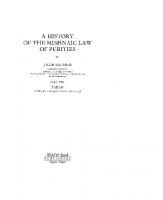
![A History of the Mishnaic Law of Purities, Part 3: Kelim: Literary and Historical Problems (Studies in Judaism in Late Antiquity) [Reprint ed.]
9781597529273, 1597529273](https://ebin.pub/img/200x200/a-history-of-the-mishnaic-law-of-purities-part-3-kelim-literary-and-historical-problems-studies-in-judaism-in-late-antiquity-reprintnbsped-9781597529273-1597529273.jpg)
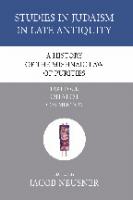
![A History of the Mishnaic Law of Purities, Part 8: Negaim: Literary and Historical Problems (Studies in Judaism in Late Antiquity) [Reprint ed.]
9781597529327, 159752932X](https://ebin.pub/img/200x200/a-history-of-the-mishnaic-law-of-purities-part-8-negaim-literary-and-historical-problems-studies-in-judaism-in-late-antiquity-reprintnbsped-9781597529327-159752932x.jpg)
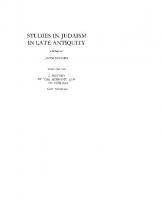
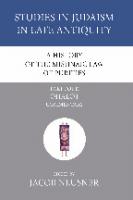
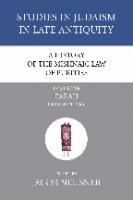
![A History of the Mishnaic Law of Purities, Part 15: Niddah: Commentary (Studies in Judaism in Late Antiquity) [Reprint ed.]
1597529397, 9781597529396](https://ebin.pub/img/200x200/a-history-of-the-mishnaic-law-of-purities-part-15-niddah-commentary-studies-in-judaism-in-late-antiquity-reprintnbsped-1597529397-9781597529396.jpg)
![A History of the Mishnaic Law of Purities, Part 15: Niddah: Commentary (Studies in Judaism in Late Antiquity) [Reprint ed.]
9781597529396, 1597529397](https://ebin.pub/img/200x200/a-history-of-the-mishnaic-law-of-purities-part-15-niddah-commentary-studies-in-judaism-in-late-antiquity-reprintnbsped-9781597529396-1597529397.jpg)